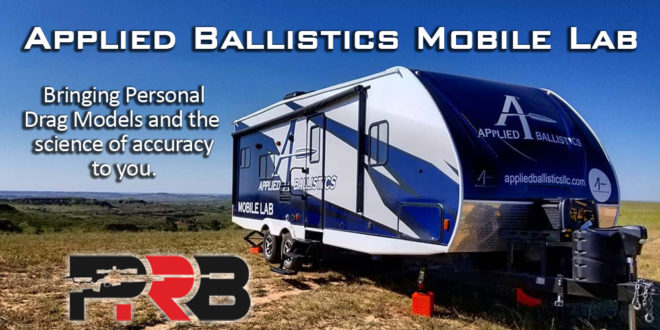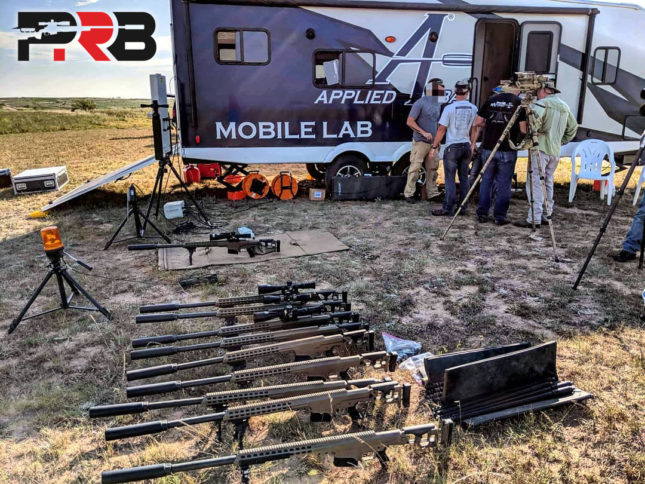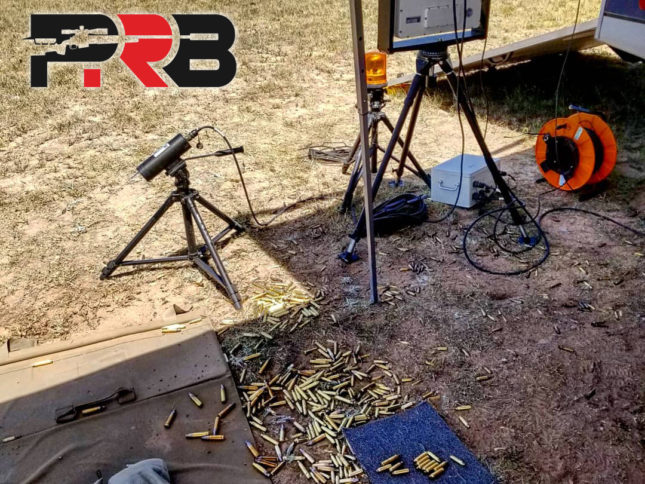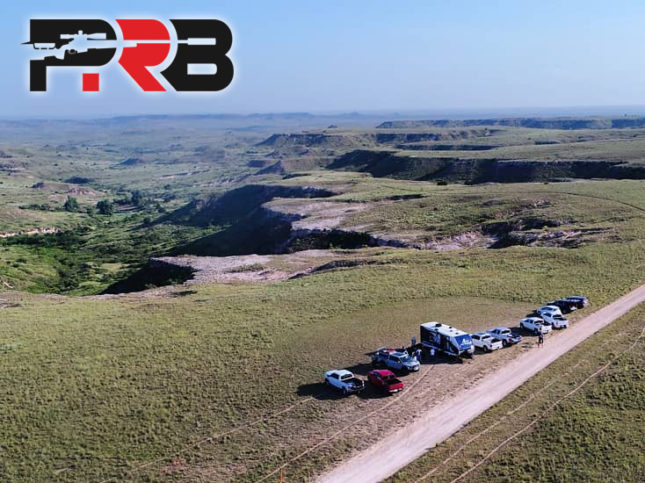Well, when I started writing that last article on personalized drag models being the final frontier of predictive ballistics, I honestly believed I was going out on a limb and trying to predict something that might be years away. It turns out it was only months away! Welcome to the future! 😉
One of the biggest benefits I get as the author of PRB is getting to meet industry experts and have interesting conversations with the leading minds in various fields related to long range shooting. I absolutely love those conversations, and value them more than any payment I could ever receive. When I write an in-depth article on a technical topic, I reach out to a couple people who are subject matter experts to fact check my rough draft and give me honest feedback before I publish. I never want to become a source of bad information, and these guys help me with that commitment. Their time is always in high demand, so I’m sincerely grateful for their help.
When it comes to ballistics, at the top of the list of experts you’ll find Bryan Litz and his team over at Applied Ballistics, and Dave Emary, long-time Chief Ballistician at Hornady. Those guys fall into what I describe as “scary smart.” They’re doing much of the cutting-edge, primary research that is pushing the industry forward. So as I was writing the last two articles (Article 1 | Article 2), I reached out to those guys and they were kind of enough to read through my drafts and offer some valuable input and corrections before those were published.
A major part of that content was related to what I was referring to as “Personalized Drag Models,” which was the idea of creating a drag model for your exact ammo fired out of your exact rifle. As I covered in the last article, there are several factors that can slightly affect the drag of the bullet, such as the barrel twist and length, if a muzzle brake is used and which specific type of muzzle brake, and even the type of gun powder in the ammo. Knowing that, wouldn’t it be cool if we didn’t have to use a single BC number to calculate our ballistics or even a bullet-specific drag model, but could somehow use a high-resolution Doppler radar to measure the exact drag of a specific bullet fired from our specific weapon system and ammo … and then somehow feed that into the ballistic calculator on my Kestrel or phone app? The problem is the equipment necessary can cost over $100,000, but I suggested a couple possibilities in the last post that I thought were plausible to get personalized drag models into the hands of the shooting community.
When Bryan Litz and Robert Brewington (co-owner of AB) had a chance to read through my rough draft, they must have had a good laugh, because they were already well down the path of weapon and bullet specific drag models! They were even calling them Personal Drag Models! They quickly replied, “Cal, you are most definitely clairvoyant! You are 100% correct in assuming the next frontiers are in profiling and characterizing complete weapon systems. Everything in the system does really matter and even identical weapons can have subtle but meaningful difference in drag profile. We are literally sorting out right now how to make Personal Drag Model generation possible for the masses.”
How crazy is that?! Towards the end of my last article I wrote, “While we’ve come a long way, and the technology and data we can take advantage of today is amazing – fully personalized drag models don’t seem to be farfetched. In fact, it seems like an obvious next step in the progression.” So while I shouldn’t be surprised, I certainly wasn’t thinking it’d be that quick! The Applied Ballistics team usually seems to be thinking a few steps ahead of most people, and that proves to be true again in this instance.
While we’re all aware of Applied Ballistics and their significant contributions to the shooting community, most of their work is related government-funded research and development for defense programs. AB is absolutely committed to helping our soldiers be more effective in combat and protect American lives. However, as the AB team furthers the science of ballistics through those high-budget defense projects, they take lessons and advancements learned and try to disseminate those in a way that can be easily applied by the masses. This is a great example of that. Here is how Robert explained this initiative to me:
“As you know and understand from running a business, it’s not cheap to send people, equipment, and resources across the country, so we’re trying to work through what that might look like. Big picture: We want to make Personal Drag Models (PDM’s) accessible and a reality for the shooting community. Our goal is to try to find a way to keep the cost to the end-user very low, or even free if possible, so this can have a legitimate impact on the masses. This seems to fit nicely with our new Applied Ballistics Training Division, which is a mobile entity. We’ve even started working on a mobile lab that will be decked out with all the latest equipment and technology.”
– Robert Brewington, Co-Owner of Applied Ballistics & Accuracy 1st
Recently, they announced the Applied Ballistics Mobile Lab is now a reality! Its maiden voyage was out to a private event held at Todd Hodnett’s ranch in west Texas. Todd is one of the premiere long-range shooting instructors in the world, and he runs Accuracy 1st which trains Tier 1 snipers and other elite marksmen. Here are a few photos from that event:
The next stop for the AB Mobile Lab was the NRA National Championships at Camp Atterbury. Applied Ballistics hopes to bring their mobile lab to these kinds of large and/or special events to give shooters an opportunity to shoot under their Doppler radar and have PDM’s generated for them. While they haven’t worked out all the details of what this will look like long-term, they may try to add an additional day onto extreme long range rifle matches or training seminars to offer this as an optional, low-cost service for everyone who signs up. They’ve also been talking to a few large optics, firearms, and ammunition companies about sponsoring special events to help spread the overhead costs associated with this effort – and possibly offer the service for free to anyone who attends!
One of the upcoming events where you can access the Applied Ballistics Mobile Lab is the 2019 Precision Rifle Expo, which will be held September 28-29, 2019 at the Arena Training Facility in Blakely, Georgia.
It’s super-exciting to think that the average shooter could have access to shoot under a Doppler radar, and have a drag profile created for their unique weapon and ammo. While I was at the King of 2 Miles extreme long range rifle match a few weeks ago, I talked to a few of the top competitors who were able to do just that and were using Doppler data recorded for their weapon/ammo in their firing solution at the match. That even included a couple shooters outside of the Applied Ballistics team, so this concept seems to be catching on. I can’t wait until I have the opportunity to do this myself! When I do, I’ll be sure to let you guys know more about how the process works and what the results are in terms of hits at extreme long range in the field.
Beyond Personal Drag Models
One last thing I’m excited about is that as shooters fire different weapon systems under the radar, the Applied Ballistics team will be collecting a lot of high-resolution data. Over time, they’ll compile a massive sample size of Doppler data for weapons with virtually every permutation of characteristics, and then they’ll be able to analyze that data to get a better understanding of the variance you can expect to see from different factors.
“The problem is more complex than just drag,” Robert explains. “It also has a great deal to do with changes in internal ballistics, and we’re working on ways we can make that more predictable as well. Hopefully within the next several months to years new products will start becoming available to manage all of this much more holistically. I personally am very excited for where all of this is headed.”
So they’re not only providing a great service to the shooting community (as if that wasn’t enough), but will be furthering the science of accuracy in other ways at the same time. I won’t even guess at what we may learn from all that, but I bet the AB team finds some way to use it to help us get more first-round hits in the field.
Bryan Litz Receives NDIA Carlos Hathcock Award
In related news, Bryan Litz was the recent recipient of the National Defense Industrial Association’s Carlos Hathcock Award. The Hathcock Award is named after the legendary Gunnery Sergeant Carlos N. Hathcock, II, USMC, and is presented to recognize an individual who has made significant contributions related to small arms weapons systems which have improved the capabilities of the U.S. military. Congratulations, Bryan! That is well-deserved recognition.

 PrecisionRifleBlog.com A DATA-DRIVEN Approach to Precision Rifles, Optics & Gear
PrecisionRifleBlog.com A DATA-DRIVEN Approach to Precision Rifles, Optics & Gear









Cal, interesting how science fiction becomes science fact. Personally I can envision a time when our PDM is expressed as a formula. Change a variable, plug into the formula for new data. Imagine a Tracking Point style optic loaded with your PDM. Soon the human factor may be taken out of long range shooting.
Joseph, it certainly seems to be headed in that direction. Taking the non-deterministic factors and moving them to deterministic. Our understanding has certainly matured over the last 50 years, and the last 10 years in particular … and innovation and learning just seem to be speeding up. Certainly a fun time to be part of this game! I appreciate you sharing your thoughts.
Thanks,
Cal
Cal, keep us up on where these events take place or a link to follow where Applied Ballistics is going to set up. Would love to see how my redone Gunwerks LR -800 does!
I hope to make one myself! I’m not sure that they have a full schedule worked out, but I’ll try to share one if they do.
Neat, but I can’t help but think that if enough people did the Labradar hack to do short range Doppler measurements there would be a lot more data generated than one trailer could.
There would be the issue of collecting and analyzing that data but having both data sets will be better than one.
I still have a feeling that if a Labradar is measuring the most variable part of a bullet’s flight, fitting the rest of the curve should give good results and extrapolating from recent measurements are probably going to surpass the accuracy of old measurements even if they start with much more long range data.
So everyone, hack your Labradar, share the results, test it against the trailer, etc.
Dan, I appreciate your passion … but after long conversations with these guys on that very subject, I’m convinced the LabRadar is great at what it was designed for (i.e. calculating muzzle velocity) … but it is a FAR cry from what their Doppler can do, in both resolution and distance. Not saying there isn’t something to learn, but just not sure consumer devices will teach us as much as you think. I do think there will be significant advancements in consumer advance over the next couple years, and I bet we get headed in that direction … but for now, I’m looking forward to the data the trailer collects.
Thanks,
Cal
Thanks,
Cal
I can’t wait to set up a custom BC for my rifle. This is so interesting
I agree!
Cal, what is your current phone ballistic app?
How recently have you evaluated what’s available?
Hey, CR. I actually looked at all the apps a couple months ago when I wrote the “Ballistic Apps – What The Pros Use” (https://precisionrifleblog.com/2019/05/22/ballistic-app/)
It was really interesting to see all the new apps that had come to market over the past couple years. I personally have used Ballistic AE for several years. But, after looking at all the apps I was very impressed with Strelok Pro, and went ahead and bought it and have used it some since then. It seems like the most feature-rich app out there at this point. Most people use GeoBallistics BallisticARC, so that’s a good choice too. And the free Hornady app is good, especially if they have the Doppler drag data for the bullet you are using.
I gave a quick summary of each app in that post, so you might find that helpful.
Thanks,
Cal
What kind of gear and methodology do they use to determine the PDMs?
You mentioned that LabRadar can’t do much more than getting MV, but is it any good at all for short-range data?
Thanks,
Tony
Hey, Tony. Great question! I don’t have all the details, but I do know that AB owns multiple Doppler radars, including a Weibel 10 GHZ Radar. Many other companies like Hornady and Barnes Bullets own a Doppler radars made by Infinition, and AB owns three of those too … but I’m told the Weibel has significantly higher fidelity, and all of the performance metrics on the model they have are higher than any model Infinition makes. Because of that, it’s price tag is higher too, so that’s why more people don’t own one, but the way I understand it Weibel is considered the gold standard in that space and that’s what they’re packing around in the trailer. So pretty exciting to have access to that!
As far as what the rest of the equipment in the trailer, I know they have monitors/TVs and equipment to monitor target cameras down range and I’m not sure what else. I would expect it to have other state-of-the-art equipment, but don’t have all the details.
The methodology to determine the PDM is basically taking the high-resolution Doppler data and using that to determine the drag on the bullet at various points in flight, referenced to bullet’s Mach speed. The way I understand it they basically construct something similar to a Custom Drag Model (explained in this article), but it has a TON of points on it all the way down range so that it perfectly matches the exact drag of your bullet when fired from your rifle. Here is an example of data a Doppler bullet trace produces, which was published by Flat Line Bullets for their 30 caliber 155gr bullet. Then they convert that to a format that can be loaded into the AB engine on your Kestrel, the AB phone app, or other devices.
An industry pro that is very familiar with radars (and is a lot smarter than me) told me about some serious limitations of related to using the LabRadar to calculate drag, and I’ll try to summarize what they said: First, he was a big fan of using the LabRadar for what it was designed to do, which is using Doppler to infer an accurate muzzle velocity. BUT, he had a serious issue with people thinking that system could be used for drag calculations. In fact, he thought that “is beyond a crap shoot.” The LabRadar is designed by Infinition, which is the same company that makes the $100,000 models companies like Hornady and Barnes Bullets uses. However, the LabRadar operates at 28 GHz, has a limited amount of power it can push, and has smaller transmitters and receivers – all of which were design choices to constrain costs so they could reach the price point attainable by consumers. It still performs the intended function really well (and is what I personally use ALL THE TIME to measure my muzzle velocity), but using it do to drag calculations is well beyond what it was designed or ever intended to do. The trace file it records has large degrees of uncertainty in it, and while the data is good enough to calculate the muzzle velocity, trying to derive drag from the trace “is more likely to be way off than correct.” Honestly, you need a high degree of certainty in the recorded drag to improve over a BC that was either trued or experimentally measured. Even then, it is a slight improvement … but using a device to calculate the drag that was never intended to do that would likely introduce more error in the firing solution than if you simply used a single-number BC.
Hey, I like to tinker and hobbyists push the boundaries of what something was designed to do all the time, but this seems like a case where you really are just being wishful to be able to use the LabRadar in it’s current form/model to do this. If I added to the confusion of whether it can be used for that through my last post, I apologize. I tried to make it really clear that I didn’t think the LabRadar could be used for that. Here is a direct quote from my article:
The industry pro I was referencing actually read over my draft and suggested I remove the part about the LabRadar so people didn’t think they could use it for that, but I just worked on rewriting it to make it clear that wasn’t what I was suggesting … but now after all the comments, I’m realizing he was probably right. I’d say it was a waste of time at this point. Personally, I’d just use Litz’s published BC before I trusted the data derived from trace files in the LabRadar. … or I’d go fire under the Wiebel Doppler radar in the Applied Ballistics Mobile Lab!
Sorry for the long-winded response. Don’t mean to get on a soapbox or feel like I am chewing you out or anything! 😉 I just wanted to try to correct any confusion I may have caused related to using a LabRadar to calculate drag, because I bet there are a lot of other readers who are wondering the same thing. Thanks for the opportunity to clarify.
Thanks,
Cal
Cal, Thanks for this tech update. For my budget a Magnetospeed V3 and Hornaday 4DOF ballistics table (for Hornady 6.5 mm bullets) is about as advanced as I get.
Of course I “true’ everything on the range.
The next tech purchse for me is a Kestrel 5700 with AB engine. Then I’ll give my wallet a rest for a few seasons.
BUT LARGER SHOOTING CLUBS MIGHT WANT TO INVEST IN ADVANCED DOPPLER SYSTEMS. jus’ sayin’… ;o)
Eric, I definitely think you’re on the right track. This is really only relevant to those that are shooting tiny targets at extreme long range and first-round hits are a major priority. It’s a niche thing. I think what you are using is a wise choice. I don’t say that lightly. But you are using one of the only two chronographs I trust (MagnetoSpeed or LabRadar), and then you’re feeding that into one of the best ballistic engines available (and there are a lot out there … but Hornady’s 4DOF is a great one).
Going over to a Kestrel weather station that will automatically sample the onsite atmospherics and adapt the ballistics solution is a pretty sweet way to go. That’s what I personally use, and I’ve used it to get first round hits in competition out to 1.5 miles. I consider it a best-of-class solution.
And I agree that large shooting clubs might consider investing in advanced Doppler system. I could totally see that as being another way to get shooters access to that kind of equipment before it is within reach of the individual consumer. Great idea!
Thanks for sharing your comments, Eric!
Thanks,
Cal
Cal, that isn’t long-winded. That is a thorough explanation. Litz’s books are long-winded! (Sorry, Brian).
I’m all about knowing the “why” behind the reason/logic. Thanks for spelling it out.
Tony
Thanks for all the great info. Will you be doing a “What the Pros Use” for reloading components? Interested to see if there has been a significant change over the last few years or if the Hybrids still dominate.
Thanks Again,
Steve
Good question, Steve. I was thinking I might do a post on that next, and you probably just encouraged me to make that happen. 😉
Thanks,
Cal
Cal, let me encourage your encouragement. Please write a blog about precision rifle reloading.